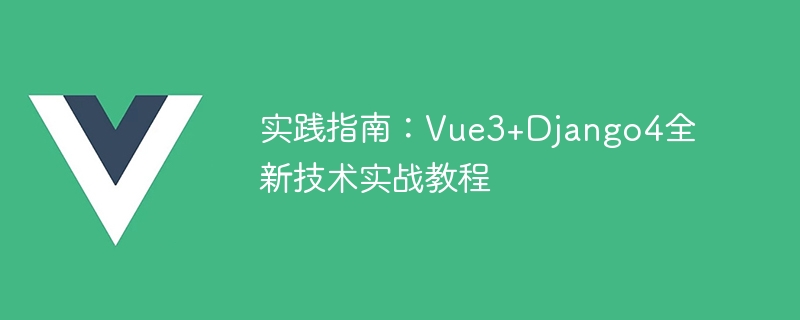

Practice Guide: Vue3 Django4 New Technology Practical Tutorial
Introduction:
In today's software development field, the architecture of front-end and back-end separation has become Mainstream, Vue.js and Django are also very popular front-end and back-end frameworks. At the end of 2020, Vue3 and Django4 were also released one after another, bringing many new features and improvements, bringing developers a better development experience and performance optimization. This article will introduce how to use Vue3 and Django4 for new front-end and back-end separation development, and provide some practical guides and techniques.
Text of article:
Part 1: Front-end development
First, we need to install Node.js and Vue CLI. Node.js is a JavaScript runtime environment based on the Chrome V8 engine, and Vue CLI is the official scaffolding tool of Vue.js.
Creating a new Vue project using the Vue CLI is very simple. Run the following command in the command line:
vue create my-project
This will generate a new Vue project and automatically install all necessary dependencies.
The core feature of Vue is component development. In Vue3, some new syntactic sugar and improvements are added, such as <script setup>, which makes component writing more concise and intuitive.
In Vue, you can use HTTP client libraries such as Axios to interact with the backend. Axios can be installed and introduced on demand, and then HTTP requests can be sent in the component.
Part 2: Back-end development
In order to build a Django development environment, we need to install Python and Django:
pip install Django
Using the command line tools provided by Django, we can easily create a new Django project:
django-admin startproject myproject
This will create a project named The new project directory for "myproject".
One of the core features of Django is the built-in lightweight web framework, which can help us quickly write API interfaces. We can create a Django application and write view functions to handle HTTP requests and return corresponding data.
Django provides a powerful ORM (Object Relational Mapping) tool that can help us easily interact with the database. We can define model classes to describe the data structure, and then use ORM to perform database operations.
Part 3: Front-end and back-end connections
Due to the front-end and back-end separation architecture, the front and back ends are deployed on different domain names or ports , cross-domain problems will occur. A common way to solve cross-domain issues is to configure a policy in Django that allows cross-domain requests.
In an architecture where the front and back ends are separated, authentication is an important issue. We can use JSON Web Token (JWT) to implement stateless authentication and pass authentication credentials between the front and back ends.
The front and back ends transmit data through API. We can use Axios to send requests and handle responses, interacting with view functions in Django.
Conclusion:
This article introduces a practical guide to using Vue3 and Django4 for new front-end and back-end separation development. Through these technologies and tools, developers can develop modern web applications more efficiently and flexibly. Of course, in addition to the above, there are many other technologies and details that we need to learn and master in depth. I hope this article can provide you with a good starting point and play a role in actual projects.
Reference materials:
The above is the detailed content of Practical Guide: Vue3+Django4 new technology practical tutorial. For more information, please follow other related articles on the PHP Chinese website!